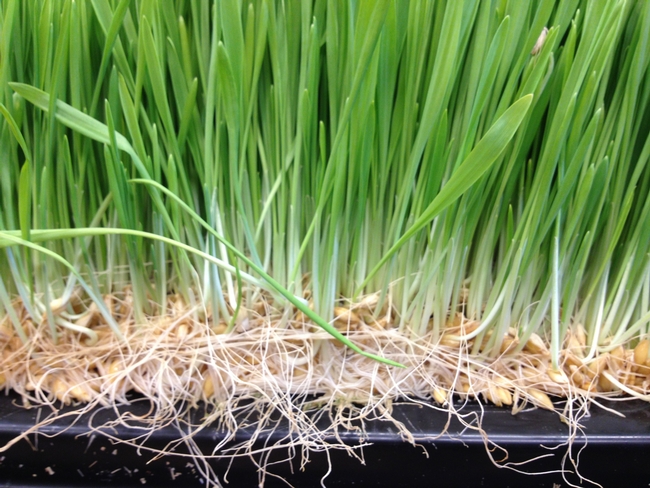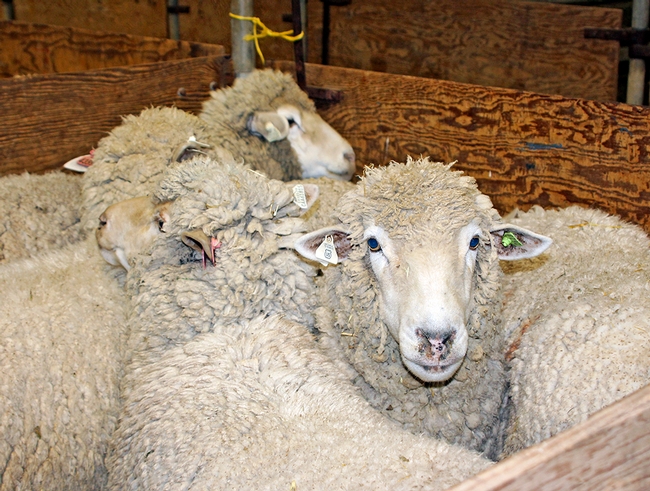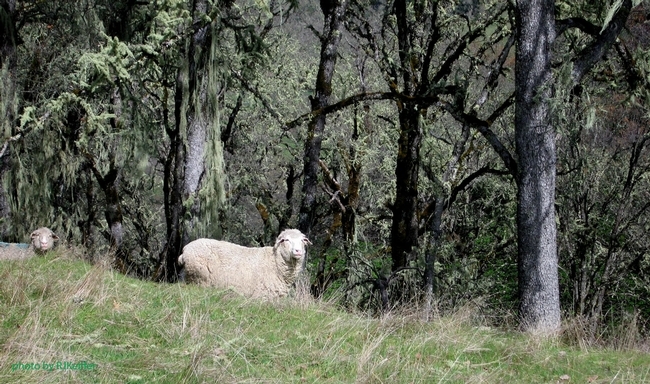Posts Tagged: sheep
Madera farmer says feeding sprouted grain to sheep improves milk quality
A Madera farmer is sprouting barley hydroponically inside shipping containers on his farm to produce feed for his sheep, reported Ezra David Romero on Valley Public Radio.
“I think that's a big advantage if you don't have a lot of land,” the farmer said. “You can produce a tremendous amount of feed in a very, very small area with a very little amount of water.”
However, UC Cooperative Extension alfalfa specialist Dan Putnam noted in the story that the system may not pencil out.
"If you really apply a little bit of economics to it and animal nutrition to it, it doesn't appear quite as promising as one might think," Putnam said.
There is no question that animals find the sprouted barely delicious. Online videos show cattle and horses "gobbling up sprouted grain like a vegetarian at a salad bar," Putnam wrote in a 2013 blog post that asked Does hydroponic forage production make sense? Things are not always as they seem. Animal ration calculations are based on dry matter since water is provided separately.
"A feed with 90 percent water (such as sprouted grain) has considerably less 'feed value' than something with only 5 percent water (such as the grain itself), on a pound for pound basis," Putnam's blog post says.
Feeding sheep sprouted barley makes sense to Mario Daccarett, the owner of the Golden Valley Farm. He said cheese made from his sheep's creamy milk is sold in places like Whole Foods.
"They have our cheese there and they tell me that our Golden Ewe cheese is the best for grilled cheese sandwich ever, and they have over 500 different varieties of cheese there," Daccarett said.
The farmer feeds his sheep one part oats and hay and one part sprouted barley.
“You do the math and you say, 'Well, yeah, it might not work,' but once we started doing it we found out that sheep tend to eat less, more nutrition, more enzymes,” Daccarett said. “So they become more efficient.”
UC sheep shearing school prepares students for gainful employment
“I tell my sheep shearing students, ‘You'll never be unemployed,'” said John Harper, UC Cooperative Extension livestock and natural resources advisor in Mendocino County. “And you'll never be poor.”
Shearers can earn $50 to $100 per hour, Harper said, and can start a business with a $3,000 investment in equipment.
“If they can learn how to shear sheep correctly, it's a great little business to get into,” Harper said.
The need for skilled sheep shearers in California and other parts of the nation has prompted the UC Hopland Research and Extension Center to host an annual sheep shearing school, where a diversity of students are introduced to a trade that allows them to work with their hands, out-of-doors, when and where they want.
Although sheep shearing is traditionally a male occupation, Harper said he encourages women to take the course.
“Women have a lower center of gravity. Strength is important, but so is hip rotation,” Harper said. “The sheep's skin is very loose and the blades are pretty powerful. The female students tend to be more cautious and we see fewer nicks.”
Beatrice Thomas, 41, is a typical student.
“I came to sheep shearing by way of dance and the arts,” Thomas said.
She left her Bay Area desk job about a year ago. “There wasn't a mind-body connection,” she said. “Forty hours at a desk, my body was aching.”
But sheep shearing was a completely different experience.
“This doesn't hurt the same way as sitting at a desk, because it feels vital. Every move is important. There's a dance. There's a rhythm. My whole spirit lit up,” Thomas said.
The 5,200-acre Hopland Research and Extension Center is home to a flock of about 1,000 sheep, which provide opportunities for scientists to study their role in land management. They also serve as a ready supply of animals for prospective new shearers to learn the craft.
“We teach students how to shear in a way that ensures the welfare of the sheep, produces a quality wool clip, and keeps the shearers safe,” Harper said. “We received a grant from the National Sheep Industry Improvement Association to purchase new shearing equipment. This allows the students to learn with brand new, state-of-the-art combs, cutters and hand pieces.”
The annual sheep shearing school at Hopland is the only intensive five-day course in the United States, said Hannah Bird, community educator at the research center.
“It brings people from all over the country and sometimes outside the country,” she said.
The week together helps build camaraderies amongst the newly trained sheep shearers. Hopland sheep shearing alums have created a Facebook group to stay in touch and refer jobs to one another. Several previous students are making a living a sheep shearing. One is Stephany Wilkes, a 2013 sheep shearing student who now runs her own sheep shearing business from San Francisco.
“People always ask me, ‘How can you run a sheep shearing business and live in the city?'” Wilkes said. “But there are actually a lot of sheep in the Bay Area, in Marin County, Solano and Yolo. I shear in Hayward and as far south as Gilroy. I go can go anywhere a car can.”
Lead instructor Gary Vorderbruggen said a key to sheep shearing success is a calm demeanor.
“Sheep don't need to be riled up. If you can be calm, and be safe, you will gain speed with experience,” Vorderbruggen said. “It's no different than a dance. It's like a square dance, except you're doing that square dance with an unwilling partner.”
Joining Harper and Vorderbruggen instructing the class in 2016 was Trevor Hollenback. He was first exposed to sheep shearing when visiting a friend's sheep farm in Austria.
“I realized this is a really skilled craft. It's amazing,” Hollenback said.
Hollenback quit his desk job and traveled to New Zealand for training, then returned to the Austrian farm for more practice. Back in the United States, Hollenback opened his own business and began shearing sheep in California and Arizona. He was tapped to be the instructor at Hopland because of his formal training in New Zealand.
“One of the most important things that the students can take away from this course is going to be sheep handling, how to move the sheep around, how to control the sheep on the board,” Hollenback said. “A lot of students came here with very little background in livestock. Footwork, positions, getting the pattern down – all the finer points in shearing – that comes with practice.”
The week-long sheep shearing school at Hopland will be held again in spring 2017. The class typically fills up within two hours of opening registration. Register interest on the UCCE Mendocino website to be notified when registration opens.
View scenes from the 2016 Sheep Shearing School at Hopland in the video below:
'Wild and wooly' sheep shearing class held at Hopland
Many sheep shearing students said the process was "the hardest thing they have ever done," reported Glenda Anderson in the Santa Rosa Press Democrat. The newspaper ran a lengthy feature and a photo gallery of the annual sheep shearing school held at the UC Hopland Research and Extension Center this week.
Reporter Justine Frederiksen of the Ukiah Daily Journal also reported on the sold-out sheep shearing and wool classing training at the 5,300-acre Mendocino County research center.
“And 60 percent of these people had never even touched a sheep before,” said John Harper, UCCE advisor and shearing school leader. Nearly all the students were women and included an artist from San Francisco, a retired fire chief, a UC Davis graduate student, and a woman who was learning to shear ahead of travels to New Zealand “because I think it will be a good skill to have for work, in case I want to stay for a couple of months.”
“One of the things new students have the most trouble with is what we call ‘tipping' the sheep, or flipping them over,” Harper said. He explained that, to get the sheep into the ideal starting position, you need to push its back legs down with one hand and tuck its head in with the other, twisting the animal into a sitting position with all four legs dangling.
UC Hopland REC sheep shearing students are part of a new wave of sheep shearers and wool enthusiasts industry officials hope will reverse decades of disinterest and decline. The shearing classes were booked well ahead of time, said Hannah Bird, a community educator at the research station. Many students are seeking a break from city life or jobs tying them to a desk.
Wrote reporter Glenda Anderson, shearing sheep is sweaty, back-straining work that earns just $2 to $5 per sheep. But an expert sheep shearer taking part in the program said sheep shearing for a living has its benefits.
“It's a lifestyle thing. I could work six months a year and travel around the world,” paying for the travel by working here and there, he said.
Mendocino County no longer to contract with USDA Wildlife Services
Mendocino County supervisors decided to sever ties with the USDA's division of Wildlife Services, reported Peter Fimrite in the San Francisco Chronicle. The decision was made after environmental groups said the agency was indiscriminately killing predators, such as mountain lions and coyotes, because they are a threat to livestock.
The article featured a gallery of 10 artful photos taken at the UC Hopland Research and Extension Center, which maintains a research sheep flock of 500 breeding ewes. Record-keeping of sheep losses to predators began at Hopland in 1973. Coyotes are the most serious predator problem.
Hopland staff use a variety of non-lethal and preventative methods to protect sheep from predators, such as fencing, mob grazing and frequent pasture rotation and guard dogs, according to Kim Rodrigues, the director of the research and extension facility. Currently there are five guard dogs at the center. The guard dogs bond with sheep and protect them primarily by barking and other aggressive behaviors when strangers or predators are near the sheep flock.
Research can help Californians live safely with wildlife
Winter is typically lambing season on Northern California sheep ranches - a perilous time of year. Baby lambs are vulnerable prey for wildlife like coyotes, mountain lions and bears. With increasing numbers of wildlife, both rural and urban neighborhoods are being impacted.
At the UC Hopland Research and Extension Center, we are braced for our first winter under a new policy that minimizes the use of lethal control against native wildlife that prey on our lambs and ewes. As director of the 5,300-acre Mendocino County research facility, I'm nervous for the well-being of our 500 sheep and lambs soon to be born.
The animals are defenseless, therefore it is our responsibility to protect them from predation by wildlife or other animals, such as domestic dogs. Many non-lethal methods of protecting the sheep have been implemented over the past several months. We installed and repaired fences and brought in five new guard dogs to protect the sheep.
Our new practices seemed to work last spring and summer. We can't draw research conclusions from one year of data, but the number of sheep confirmed killed by wild carnivores in 2015 was much smaller than the year before, 10 vs. 48. And the number of coyotes taken so far in 2014 – 15 – was about half the amount in 2014.
I'm encouraged by the numbers. But we want to do better. As a University of California research center, Hopland is the ideal place to study ways for sheep ranchers throughout Northern California to maintain sustainable flocks even in the presence of the growing, and increasingly diverse, wildlife population. At Hopland, we are interested in learning more about how to prevent conflicts with wild animals and reduce the need for lethal control of wildlife. This information will inform policies for wildlife control in cities, rural areas and on ranches.
The Hopland REC was a working sheep ranch when it was purchased by the UC Division of Agriculture and Natural Resources for rangeland and animal management research in 1951. From the 1990s to the 2000s, 10 to 15 percent of lambs or more were killed each year by predators – mainly coyotes – despite aggressive non-lethal and legal lethal control, according to Bob Timm, a UC Cooperative Extension specialist who served as director of the station for 30 years before retiring in 2014.
We will always have predators threatening our sheep. We need research-based information to inform us how to deal with them humanely while maintaining economically viable ranching operations in Mendocino County and throughout California.
Justin Brashares, a professor of wildlife ecology at UC Berkeley, has developed a research plan for the center. We are seeking funding and, in the coming years, will use Hopland as a living laboratory to answer many questions scientists and ranchers have about wildlife in Northern California. The research will help us estimate the wildlife population. We plan to use high-technology GPS collars on prey and predator species to develop very fine-scale information about their interactions. Hopland will also be a site to study the very fencing we and other sheep producers are earnestly installing to protect our sheep from hungry carnivores.
I believe we are lucky to have the wildlife among us. I'm committed to helping our community protect wildlife and raise sheep with research and education programs at Hopland.
We will always have predators threatening our sheep. We need research-based information to inform us how to deal with them humanely while maintaining economically viable ranching operations in Mendocino County and throughout California.






